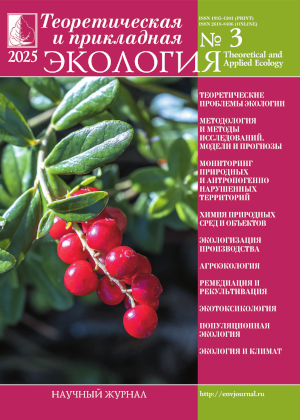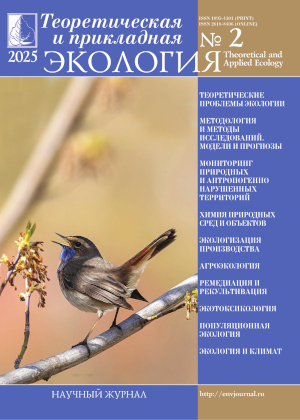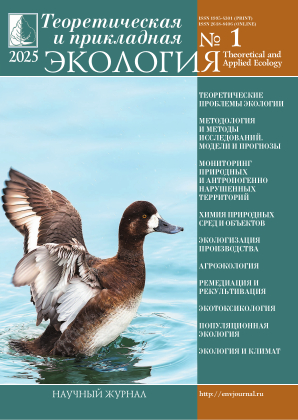 ISSN 1995-4301
ISSN 1995-4301(Print)
ISSN 2618-8406
(Online)
Rules for Contributors
The scientific journal "Theoretical and Applied Ecology" publishes articles in Russian or English on sections of ecology, as well as related sciences: original papers, review articles, chronicles and information, reviews of interest to the scientific community.
There are accepted for publication previously unpublished, original articles not sent for publication to other publications, concerning the problems of environmentally safe development of the economy and the consumption of natural resources, new theoretical and methodological approaches in assessing man-made pollution of natural environments and objects, structural and functional organization and sustainability of ecosystems in changing conditions environment, regulation of technogenic emissions and the spread of pollutants in natural environments, sanitation and rehabilitation of chemically contaminated areas, principles and technologies of waste management, ecologization of industrial and agricultural production, devoted to the formation of ecological culture of the population. Brief (preliminary) messages are not accepted.
Articles submitted to the journal undergo one-sided anonymous peer review. The editors reserve the right to reject articles that do not correspond to the profile of the journal or are designed in violation of the rules.
When preparing manuscripts, the following rules should be followed.
RULES FOR CONTRIBUTERS
1. General requirements
1.1. The recommended length of the manuscript (including abstract, list of references, tables, figure captions) is up to 15 pages (for reviews up to 20 pages), created in Microsoft Word text editor in rtf or doc format in Times New Roman font (14 size) through 1.5 intervals at standard format A4 without automatic hyphenation. All manuscript margins should be 20 mm. The paragraph indent size is set automatically and should be 1.25 cm.
1.2. Page numbering is required in the article file. The page number should be centered on the bottom of the page.
1.3. When submitting an article in English, it is obligatory to have a version in Russian (for Russian-speaking authors) to speed up the review process, as well as to check the correctness of the translation of the manuscript by the translator of the journal.
1.4. When preparing a manuscript, uniformity in designations, systems of units of measurement, and nomenclature should be kept. It is necessary, as far as possible, to avoid abbreviations other than generally accepted ones. If abbreviations are still used, then they should be deciphered in the text at their first mention.
1.5. Decimal digits are typed only through a dot..
1.6. The first mention of any name of an organism must be followed by the full scientific (Latin) name; at the next mention, the genus name is abbreviated to the first letter. Species and genus names are given in italics.
1.7. All physical quantities must be given in the International System (SI).
1.8. A period is not put after: "UDC", article title, authors, addresses, headings and subheadings, table names, dimensions (s - second, g - gram, min - minute, d - day, deg - degree, wk - week).
1.9. A space is not placed before the sign "%" (20%), when indicating the valency of the elements (copper (II)) and temperature (15 °C). The promille (parts per thousand) sign is denoted by "‰".
1.10. The names of chemical elements and compounds must be given according to the IUPAC nomenclature. The charge of an ion is denoted by a superscript symbol (Cu2+), the number of atoms is denoted by subscript symbols (Н2SO4).
1.11. Between numbers and different words in a sentence, a “–” sign is placed (5–13, not 5-13).
2. Article structure
2.1. Scientific articles proposed for publication should contain:
- Rationale for relevance (does not have a heading)
- Purpose of the study
- Objects and methods of research
- Results and discussion (for original articles) or logically related parts of the review (must have specific headings) (for review articles)
- Conclusion (or Conclusions)
2.2. In the section "Objects and Methods" in the original articles, it is necessary to indicate how the statistical processing of the obtained data was carried out; what values are shown in tables and figures (for example, arithmetic means and standard deviations).
2.3. If the error measure is a confidence interval, then it is necessary to indicate the appropriate level of confidence (recommended values of confidence probability P = 0.90; 0.95 or 0.99). The error interval is set in the form of "average" ± "error" in tables and error bars on graphs and diagrams.
2.4. When comparing variants (for example, with a control), it is necessary to indicate by what criterion it was carried out, and the significance level of the criterion (it is desirable to use significance levels p = 0.10; 0.05 or 0.01).
2.5. Rounding of data must be carried out in accordance with GOST R 8.736-2011 (Appendix E, clause 10.3): the error is rounded to one significant figure if the first significant figure of the error is greater than 3, and otherwise to two significant figures. The mean value is given with the same number of decimal places as the error. For example, 35.6±1.2; 28.7±0.4; 42000±8000; 31700±2300.
2.6. In the section "Objects and Methods" in review articles, it is necessary to indicate which search engines the authors used, what time period the search covered, for which keywords and search queries, how the information found was processed, etc.
3. Formatting the article.
3.1. The article must have a UDC index (determined by the author according to the tables of the Universal Decimal Classification).
3.2. The title should be short (no more than 8–10 meaningful words), informative, without including the names of settlements, rivers, and, as far as it's possible, accurately reflect the content of the article.
3.3. Article titles should not be capitalized.
3.4. After the title, one empty line should be followed by the last name(s) of the author(s). In the Russian version, after the surname, the academic degree and position are indicated. Below is the name of the organization, its full postal address (with index) and e-mail for correspondence with the authors.
3.5. When preparing an article, special attention should be paid to writing an abstract (author's summary) in Russian (from 100 to 250 words) and English (from 250 to 300 words) languages. If the English and Russian versions of the annotations do not match, the author sends a file with the Russian equivalent of the annotation in English for verification by the translator of the journal.
3.6. The annotation to the article is intended to serve as a source of information independent of the article and should be:
- informative (do not contain common words);
- content (reflect the main content of the article and research results);
- structured (follow the logic of the description of the results in the article);
- compact (fit within the recommended volume);
- the English text of the abstract must be:
- original (do not be a tracing paper of a Russian-language abstract with a literal translation);
- written in high quality English.
3.7. It must be borne in mind that annotations in English in a Russian-language edition are the main and, as a rule, the only source of information about the content of the article for foreign scientists and specialists. Therefore, the abstract should clearly and specifically list the main results, conclusions, and, if necessary, methods and objects. It is not recommended to use wordings like “the article discusses issues ...” and “the problem is discussed ...”
3.8. In the English translation, the English title of the article is placed before the text of the abstract: the initials and surnames of the authors in English transliteration, after which the ORCID of all authors, the name of the institution and the full postal address with the city and country in English are indicated. The names of the authors are given in accordance with the accounts of Scopus and Web of Science.
3.9. Key words (up to 8 words and phrases) are attached to the article in Russian and English. Abbreviations are not allowed in keywords.
4. Requirements for the design of tables and figures
4.1. Tables and figures should be placed in the text of the article immediately after the link to them.
4.2. All symbols are placed in a note, which is typed in italics (12 point size, 1.5 spacing).
5. Tables
5.1. Tables don't have to be bulky. Each table must have a serial number (Table 1 – right alignment; if there is one table, it is not numbered) and a title (center alignment). Column headings are capitalized and should be as concise, informative, and free of abbreviations as possible.
5.2. It is not necessary to repeat and retell in the text of the article the figures and data given in the tables.
5.3. There should not be empty cells in the tables, a dash is allowed (in the note it is necessary to indicate what it means).
5.4. In tables it is necessary to use 1.0 spacing and 12 font size. Table width is 17 cm in portrait orientation or 25.5 cm in landscape, no wrapping, center alignment.
5.5. A table should be allocated on the single page. If the table is larger, its publication is possible by agreement with the editors.
Table design example
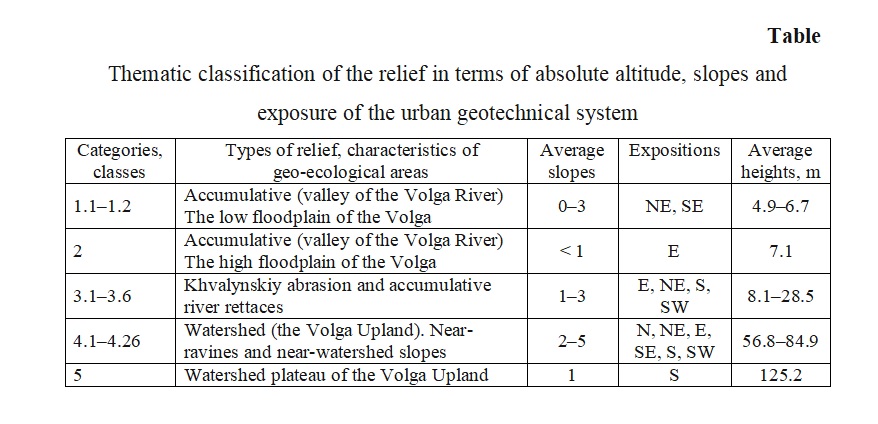
6. Drawings
6.1. The inscriptions cluttering up the figure must be replaced by digital or alphabetic designations, which must be explained in the figure captions.
6.2. All drawings are in black and white (shades of grey). By agreement with the editors, it is possible to place drawings on the colored tabs of the journal.
6.3. The axes of the graphs must be accompanied by captions reflecting their essence. If the graph/diagram shows variables, then their dimension is indicated.
6.4. Drawings are placed in the manuscript, and additionally uploaded through the personal account in the form of separate files.
6.5. If the drawing (graph, diagram) is in Excel format, then the file with the xls extension is loaded. When copying a picture from Excel, you must click "Copy as picture" (View – as on the screen, Format – vector).
6.6. Alignment of the picture – in the center, without wrapping. Image quality is at least 300 pixels per inch.
Examples of drawings design
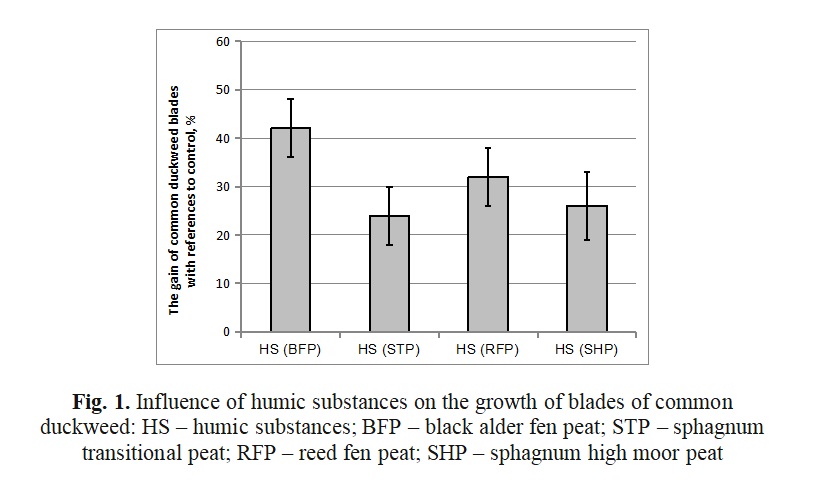
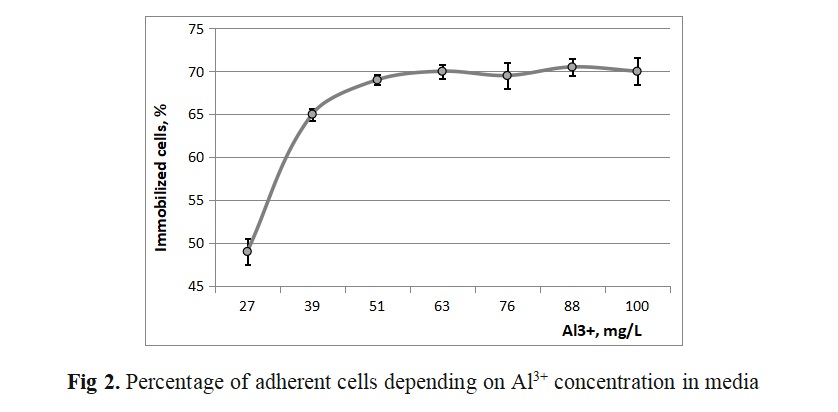
7. Formatting mathematical formulas
7.1. Formulas must be typed in the formula editor Microsoft Equation 3.0 (Insert - Object - Microsoft Equation 3.0).
7.2. If there are several formulas, they are numbered.
An example of a formula in the text of an article

8. Acknowledgments
Acknowledgments, reference to projects, contracts and grants, within which the study was performed, are given after the conclusion before the literature references and are drawn up in 14-point font in bold italics.
9. Requirements for the list of references
9.1. References to the literature are given in numbers in square brackets in the order of mention in the text.
9.2. The list of references is given at the end of the article (12 font size). Sources are numbered manually.
9.3. When making a bibliographic entry, the surnames of all authors and the full title of the cited work are given. If the publication is published under the editorship, then its title is written first, then through a slash (/ Ed(s).) and all editors are listed.
9.4. It is not recommended to refer to conference materials, dissertations and abstracts if there are similar articles in periodic scientific journals or monographs.
9.5. It is undesirable to make references to regulatory documents adopted in the Russian Federation and which are freely available, it is enough just to refer to them, for example, "... according to SanPiN 1.2.3685-2".
10. References
10.1. The titles of papers and conferences originally typed Cyrillic should be given in English translation, and the titles of publications should be transliterated. The titles of journals and collections included in the international databases Scopus, Web of Science, etc. are given according to the records in these databases.
10.2. At the end of the bibliographic record, the original language should be indicated if it differs from English.
10.3. If the publication has a DOI, then it must be indicated (this is done by the author, not the editor).
Examples of References design
Articles in journals
Abakumov E.V., Lodygin E.D., Gabov D.A., Krylenkov V.A. Polycyclic aromatic hydrocarbons content in Antarctica soils as exemplified by the Russian polarstations // Gigiena i Sanitaniya. 2014. No. 1. P. 30–34 (in Russian).
Meysurova А.F., Notov A.A. Metal and metalloid contents in lichens from specially protected conservation areas // Theoretical and Applied Ecology. 2020. No. 3. P. 58–65. doi: 10.25750/1995-4301-2020-3-058-065
Collections of articles and materials
Kabirov R.R., Gaisina L.A., Safiullina L.M., Bakiyeva G.Z., Safiullin S.Yu. Models of transformation of soil algae communities in conditions of anthropogenic contamination // Algae and cyanobacteria in natural and agricultural ecosystems: Materialy Mezhdunarodnoy nauchno-prakticheskoy konferentsii, posvyashchennoy 100-letiyu so dnya rozhdeniya professora E.A. Shtinoy. Kirov: Vyatskaya GSHA, 2010. P. 140–145 (in Russian).
Monographs
Mukhin V.A. Biota of xylotrophic basidiomycetes of the West Siberian Plain. Ekaterinburg: Nauka, 1993. 232 p. (in Russian).
Internet resources
SkyKem – Advanced hygiene technology for the aircraft industry [Internet resource] http://www.skykem.co.uk/ (Accessed: 16.08.2017).
Patent documents
Efremenko E.N., Kholstov A.V., Voronova E.N., Konyukhov I.V., Pogosyan I.S., Rubin A.B. Biosensor based on microalgae cells for detecting heavy metals and herbicides in aqueous systems // Patent RU 2426779 C1. Application: 2009141878/10, 13.11.2009. Date of publication: 20.08.2011. Bull. 23 (in Russian).
11. Submission of the article to the editorial board
11.1. Articles are submitted only in electronic form through the author's personal account on the journal's website.
11.2. Accompanying documents must be attached to the article.
11.3. In the editorial office through the "personal account" are submitted:
- article file in MS Word 2003 (rtf or doc) format (download the article template);
- additional files (pictures, up to 4 files, each is loaded into a separate cell, if there are a lot of pictures, then they can be stitched together in a graphic editor);
- scan (photo) of the license agreement signed by all co-authors for the right to use the scientific work in the journal;
- scan (photo) of the referral from the organization in any form;
- scan (photo) of the results of checking the article for anti-plagiarism + a file for checking in doc format;
- expert opinion;
- scan (photo) of consent to the processing of personal data for each author of the article.
If these requirements are not met, the article is not considered by the editors.
12. Anti-plagiarism
12.1. The editorial board of the journal "Theoretical and Applied Ecology", when considering an article, checks it using the "Anti-plagiarism" system. The degree of originality of the text should be at least 70-75%. In case of detection of borrowings, the editors, acting in accordance with the rules of the International Committee on Publication Ethics (COPE), have the right to reject the article. If a high percentage of borrowings is detected in an article, the team of authors is included in the list of authors whose works the journal does not accept for publication for two years.
12.2. Before submitting an article to the editorial office, authors must independently perform a preliminary check for Anti-plagiarism through the appropriate service and attach a screenshot of the report of the verified document in their personal account (name it: Last name of the first author_Anti-plagiarism_check). To check an article for plagiarism, we ask authors to use services and rate plans that allow a full check on all available databases (for example, FULL-L and FULL-XL rate plans in the “Antiplagiat” Service). The results of checking the article performed in demo-version or test access of borrowing check services are not accepted.
12.3. When checking, you need to delete the names of the authors, the name of the organization, addresses, keywords, figures, tables and references (this file must also be uploaded to your personal account and name it (Last name of the first author_Anti-plagiarism).
12.4. The percentage of self-citation for articles published in the journal should be no more than 20%.
13. Manuscript review
13.1. The manuscript of the article is sent for review to a member of the editorial board of the journal and / or a leading specialist in this field of research.
13.2. Reviewer's feedback is sent to the personal account of the author or to his (her) contact e-mail.
13.3. If there are comments in the review, the manuscript is sent to the author for revision. The revision term is no more than a month from the moment the author receives the review with comments.
13.4. Together with the revised manuscript, it is necessary to send a response to the reviewer's comments indicating all the changes made to the article. All changes in the manuscript must be highlighted in color.
13.5. The revised article is sent for re-review. The final decision on the possibility of its publication is made by the editorial board of the journal.
15. Publication deadlines
15.1. Currently, the editorial portfolio is full, the queue for the publication of articles is on average 1.5–2 years. In urgent cases (grant report, dissertation defense, etc.), the editors can give the authors a certificate of acceptance of the article for publication. The publication of articles is carried out on a paid basis.
15.2. A copy of the journal with the published article is not sent to the authors and is distributed only by subscription. The electronic version of the article and the journal is entirely posted on the site. The fee is not paid.
Contact phone +7 (8332) 37-02-77.
|
36, Moskovskya street, Kirov, 610000, Editorial Board "Theoretical and Applied Ecology." Phone/fax: (8332) 37-02-77 e-mail: envjournal@vyatsu.ru The journal was founded in 2007 |
||||||

